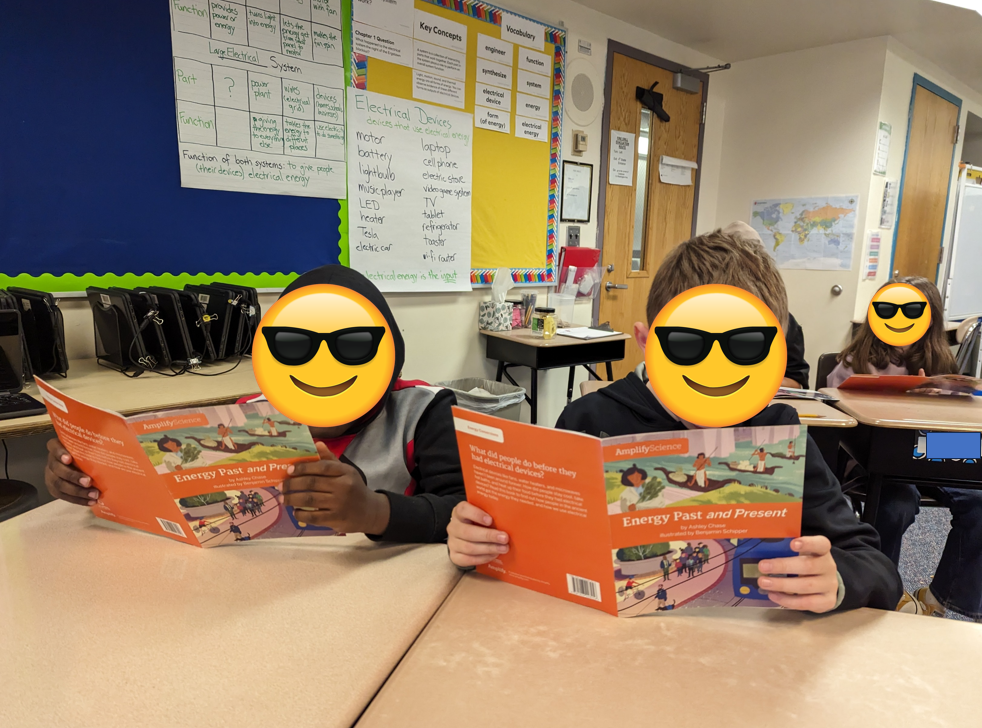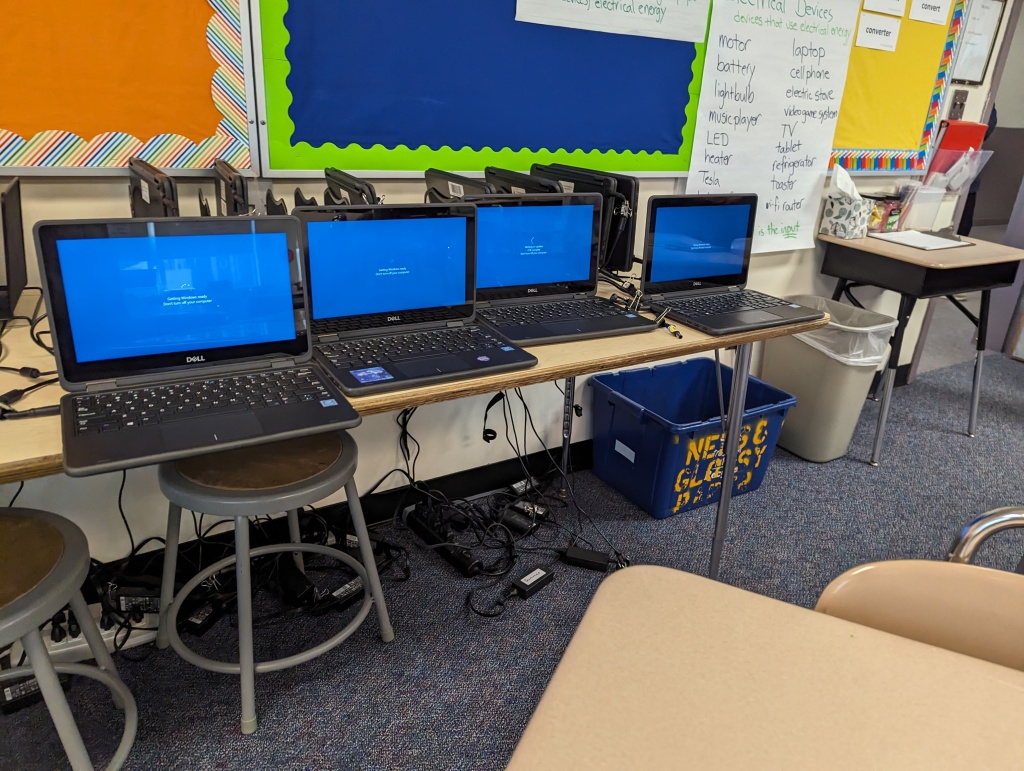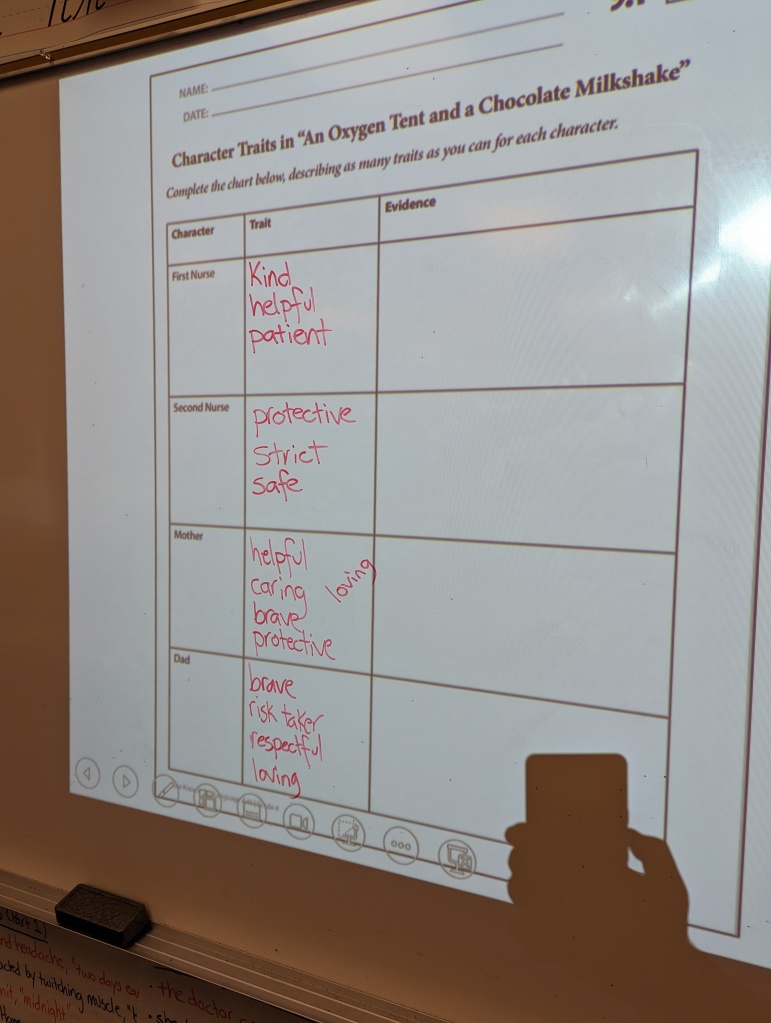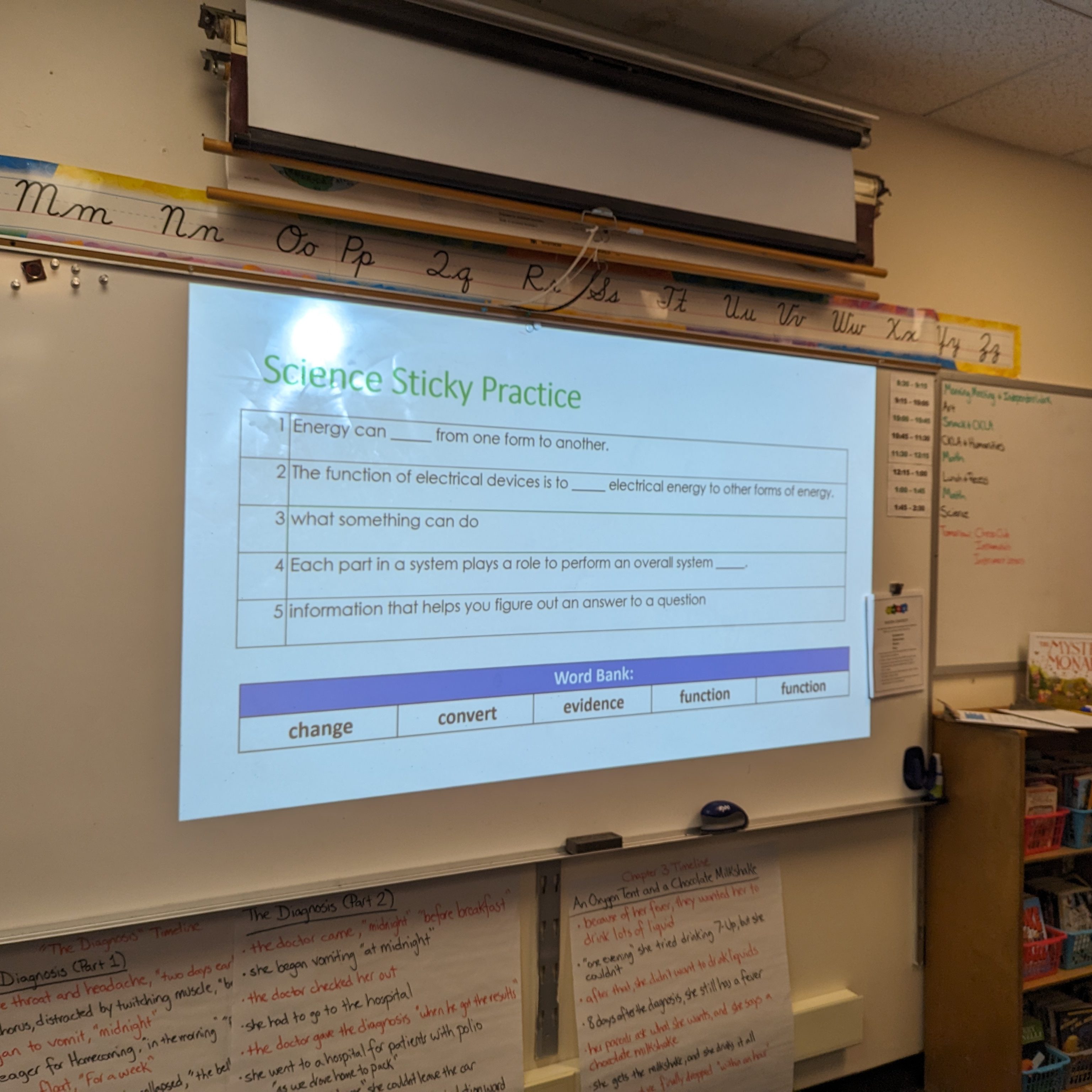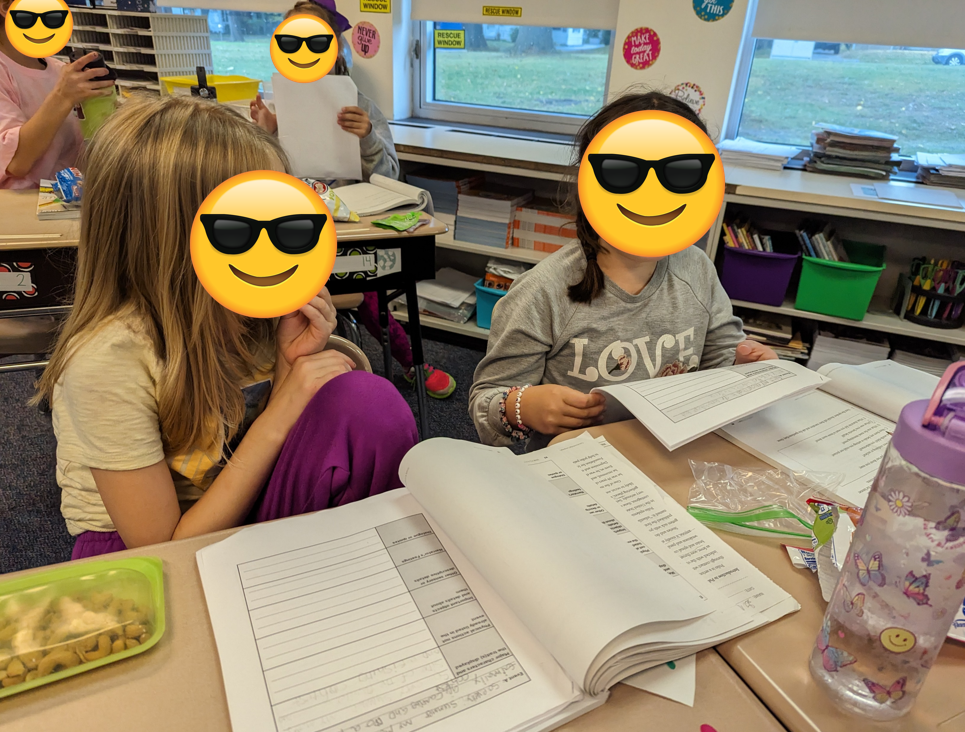After two 4-day weeks in a row, it was tough going back to a 5-day week. I can’t tell you how many times on Thursday I thought it was Friday!
By the way, I don’t think I’ve addressed it explicitly, so I want to do so now. The reason I use the headings “Amplify CKLA” and “Amplify Science” is because for those blocks of instruction I am specifically using those two curriculums very closely. Yes, those are my literacy and science blocks, but I want to be up front that anything I share about my instruction during those times is my interpretation and implementation of those two specific curriculum programs.
For math, I just say “Math” because I’m not following our curriculum program as closely. Our district adopted iReady Mathematics Classroom this year. I follow their sequence of lessons, and I pull a lot from their materials, but so much of my actual instruction is made up by me that I don’t want to give the false impression that you’ll find these activities in that curriculum. I don’t want to hide that I have and use those curriculum materials, but I also don’t want to confuse anyone who goes looking and doesn’t find something I’ve shared in those same materials.
For humanities, our district wrote its own units, so those are all home grown. There is no curriculum to name. I do add my own spin on some of it. For example, the map activities I share in this post were made up by me. Since nobody reading this has access to our district units, it doesn’t really matter as much whether you know I made something up or I used it from our units.
Day 26
Humanities
Today we reread the article “Meet the Haudenosaunee.” We stopped to talk about the role of men and women in government. When I asked for the three roles women had, my students were only able to come up with two:
- removing men from the Grand Council
- helping the men who were on the Grand Council
I asked them to go back into the text with their partner to find the third role, and they were stuck! I quickly reread the paragraph, and that’s when I finally realized why they were unable to figure out the third role.
I copied this sentence on the board. See if you can figure out what comprehension issue it caused for my students:
“Clan mothers were women who chose and helped the men who were on the Grand Council.”
I asked my students to identify the two actions in the sentence. They were able to come up with “chose” and “helped.” Then I explained how authors will sometimes put two actions in the same sentence when writing two sentences would reuse almost all of the same words. We practiced reading the sentence with one of the actions and then the other:
- Clan mothers were women who chose the men who were on the Grand Council.
- Clan mothers were women who helped the men who were on the Grand Council.
Then I asked students what the third role women had, and students were able to tell me.
To practice this sentence structure again, I wrote a new sentence on the board, and we practiced reading and making sense of that sentence.
After learning last year that a lot of comprehension breakdowns occur at the word and sentence level, I’m trying to be more aware of when that might be happening with my students like it did today.
Amplify CKLA
Today’s Amplify CKLA lesson opened with a review of the vocabulary words students learned while reading our latest personal narrative.
This curriculum throws a LOT of vocabulary words at students and has a very scattershot approach to doing any sort of learning about the words. Most lessons just open with the directions, “Introduce today’s vocabulary words if you want to.” This is the first time we’ve ever revisited vocabulary words in a later lesson.
After a recent training, at least now I understand that every unit after unit 1 will include some word work after every activity where students read. The lessons will still bombard students with lots of words, but the teacher will spend a little time studying *one* word with students after every reading.
After reviewing vocabulary words in our Amplify CKLA lesson, my students worked in pairs to reread the first two sections of our latest personal narrative. As they read, they identified the character’s feelings – emotional and physical – and included text evidence for each feeling.
Amplify Science
I’m trying to get in all the science I can right now. In November, I’ll effectively lose a 45 minutes of first instruction every other day as we begin shuffling students around for literacy intervention. At that point I’ll effectively be cutting my science instructional time in half every week. So sad.
In today’s Amplify Science lesson, we learned that the role of electrical devices in the electrical system is as converters. They take the electrical energy that travels through the electrical system to our homes and businesses and convert it into other forms of energy we use, such as motion, sound, thermal, and light energy.
We also started reading a book comparing and contrasting how people have used energy in the past and present.
I specifically remember that my students last year had a difficult time wrapping their heads around the idea of electrical devices as converters. To them, the function of any electrical device is related to whatever energy is being outputted. For example, the function of a fan is to cool you off, so to them, fans “make” motion energy. Even after these lessons, I remember they still said things like, “Electricity gives the device power so it can make wind.” There’s some truth to that, but it feels like it’s ignoring all of the concepts and vocabulary we spent days learning together.
Math
Today’s math lesson opened with a Same and Different routine.
I feel like this fell a little flat because my students are not very comfortable with using models or drawings to represent addition. The standard US algorithm seems to be what they have the most experience with, and since it’s such a useful strategy for adding 5- and 6-digit numbers, I’m mostly focusing on the algorithm in my instruction this year. That doesn’t mean I let them slack off though! It just wasn’t our richest conversation.
On one hand, I’m glad I’m leveraging what my students actually do know and are comfortable with in math, but at the same time, it’s sad that they seem to have so little comfort with drawings and models. It feels like all algorithms, all the time.
After the warm up, we talked about estimating to find the sum. This was a great chance to revisit rounding, which they seem to finally be finding their footing with.
It’s a really hard sell that estimating is a “quick” way of finding a close answer though. Rounding is still such a laborious process for so many of them that just adding the numbers would be waaaaay easier and faster.
This was also a great example of how we haven’t spent enough time building any sort of number sense with big numbers. When I asked the question, “So is 80,639 reasonable? Is it close to our estimate of 81,000?” they all said, “No!”
The same thing happened with a question on their practice. The estimate was 76,000 and the exact answer was 76,237. Multiple students said the estimate wasn’t close because it’s 237 away. To them that’s still a big number! They didn’t get that when you’re working in the magnitude of tens of thousands, a difference of 237 is not very large.
There’s no work in these lessons on what it means to be close or far from a number relative to the magnitude of the numbers you’re talking about. Again, so much is assumed that students can do and make sense of with regard to magnitude and place value with no work done to develop these important understandings.
Day 27
Amplify Science
Today we continued an Amplify Science lesson. Students partner read a book about how people have used energy in the past and present and answered some questions about their reading. I love all of the books that accompany our Amplify Science units.
Before students read the book, they had to read several statements and decide whether they agreed or disagreed with each statement. After finishing the book, they were supposed to revisit the statements to decide if they still agreed or disagreed. As we debriefed, it became abundantly clear that the phrasing of several statements was so wordy and/or unclear to the students that their agreement/disagreement gave the impression that they got the completely wrong idea from the book. I like the idea of this activity, but if the statements are confusing to the students after reading the book, then they’re not supporting students in clarifying scientific ideas.
Amplify CKLA
In my continuing adventures of failing to finish an Amplify CKLA lesson in one day, we spent our second day on lesson 8 and managed to finish the second of three activities in the lesson. So, we still have one more day to go in this one-day lesson…
I even tried to speed things up. Here’s what students were supposed to do in 25 minutes:
- Reread an article called “Introduction to Polio.”
- Look for how the article describes three specific facts about polio and write it down in a table.
- Reread the first two chapters (about 6 pages altogether) of the personal narrative we’re reading.
- Look for how the narrative describes the same three facts about polio and write it down in a table.
- Have a discussion where we compare and contrast what we can learn from secondhand and firsthand accounts.
Here’s how I tried to save time:
- I reread the article out loud.
- I divided the class into three groups. Each group just had to listen for *one* of the three facts and share out when they heard it. Everyone recorded in their table.
- I reread the narrative out loud.
- Again, each student only had to listen for *one* of the three facts and share out when they heard it. Everyone recorded in their table.
- I had to drag us over the finish line, because this took us about an hour, but we did end with a brief discussion about firsthand and secondhand accounts.
Rereading the article and finding evidence about the three facts went pretty quickly. Rereading the narrative slowed us down considerably because the narrator’s firsthand account is littered with descriptions that relate to the three facts about polio. You’re immersed in it! It was a good lesson, but making sense of what you’re reading and writing about it takes time!
Day 28
Morning Routine
I should have started this sooner, but better late than never! I’ve been putting the same morning routine steps on the board for weeks now. Recently I started slowly removing images because I want the students to eventually remember and internalize the routine. I will say I can already tell that this class is doing a much better job of remembering to make their lunch choice! Last year maybe half the class would do it on a regular basis. This year I usually only have to call on 1-2 students who forgot.
Humanities
I forgot to take pictures during the first half of this social studies lesson where we looked at photos of places around New York and identified physical features that make our state diverse.
After that, we looked at a map of the lands of the Haudenosaunee nations. I asked students to study the map and share what they noticed.
“They look like they’re grouped, one next to another.”
“It’s like in the video! The Seneca are supposed to watch that side and the Mohawk watch the other side.”
I loved hearing the connection between the video we watched in our first lesson and the map we looked at today.
Amplify CKLA
In today’s Amplify CKLA lesson, we talked about the kinds of details authors use in personal narratives to bring their stories to life. Then students practiced writing details to bring to life each of the events of the personal narrative they’re about to write. Toward the end, we stopped so students could share one event from their story and the details they chose to add. We noticed that sometimes dialogue is a great detail to add, other times adding action to the event brings it to life, and other times we might want to stop and describe what something looks like for the reader. A big lesson I’m trying to impart is that there is not “right” way to write. Authors have to make choices, and those choices can be more or less effective.

During my first stint as a classroom teacher, between 2001 and 2010, I used writing workshop. It always felt like I could never get it to live up the promise of what it was supposed to do to help all of my students become skilled writers. I have to say that using Amplify’s curriculum, I’m pretty happy with the structures built into the lessons to help my students try out very specific author moves as they plan their stories. It feels a lot less scattershot than my experiences years ago.
Another big difference is that I often had students who just didn’t want to write during writing workshop. While some of my students now are slow at writing, every single student is writing this year! Sure some will be more effective than others, but they are all doing the work. It’s impressive!
Math
I’m so glad I took the time this summer to create daily spiral review (Sticky Practice) activities for my students. They take one home for homework every day Monday through Thursday. At the end of each lesson (which takes 3-5 days) we take a Sticky Quiz in class so I can see how they’re doing on the topics they’ve been reviewing for homework.
If you read any of my previous posts where I talked about teaching rounding, you’ll know this was very challenging for my students. However, I’ve noticed my students have been getting more and more confident with it after it moved to our daily spiral review. I’m also happy knowing that rounding will come back up again in our spiral review in another week or two so students won’t go too long before encountering it again.
For our core lesson today, we were supposed to start subtraction with regrouping. Taking some advice I got from Michael Pershan last year, I focused today on regrouping without worrying about subtraction at all. Instead I made it feel like a natural extension of our previous work:
If we can regroup 10 smaller units for 1 larger unit, then we can go in the opposite direction as well.
I decided to start this work using place value disks. They’re a nice middle ground between concrete and abstract, which is particularly helpful when representing large numbers. I don’t know about you, but I don’t have enough base ten blocks to represent more than 1 ten thousand.
After we had regrouped 1 ten for 10 ones and then 1 hundred for 10 tens, I asked the students, “So, we have 1 thousand, 3 hundred, 12-ty- 12. Does that have the same value as 1,432?” The class was divided. I had them turn and talk with their partner.
When we came back together, a student said no, but then he started walking me through his thinking.
S: “You can regroup 10 tens for 1 hundred.”
Me: “Ah, so these 10 tens can be regrouped as 1 hundred. How many hundreds will we have?”
S: “4.”
Me: “And how many tens?”
S: “2. And then you can regroup 10 of the ones as 1 ten.”
Me: “Ah, you can regroup again. How many tens will you have if you do that?”
S: “3.”
Me: “And how many ones will be left?”
S: “2.”
Me: “So after you do these two regroupings, is it 1,432?”
S: “Yes, I accidentally thought it would only have 2 tens when I did it before.”
Me: “So if we regroup from bigger units to smaller units we can get to 1 thousand, 3 hundreds, 12 tens, and 12 ones, but you showed us we can regroup in the opposite direction to get back to 1 thousand, 4 hundreds, 3 tens, and 2 ones.”
We continued regrouping numbers in different ways and looking at how we could record the regrouping. Students practiced on their mini white boards.
I asked my students, “So obviously this isn’t standard form or the usual way we write numbers, but could it be useful to regroup like this? Is there a reason I would ever want 12 ones instead of 2 ones?”
S: “When you’re subtracting. Sometimes the bottom number you need to take away something like 5 ones, but you only have 2. If you have 12 ones then you would have enough.”
Me: “Wow! That would be so useful, wouldn’t it? Have any of you ever noticed that before? You’re trying to take away but you don’t have enough tens or enough ones?”
Ss: “Yes!”
I ended today’s math lesson showing two of the ways of representing 1,432. I asked, “If you wanted to take away 311 from 1,432, which way of representing the number would make it easier?”
Students turned and talked with their partner, and then we came back together.
S: “I would choose the one on the left because you don’t need to do any regrouping. You can just take away the number.”
Then I said, “What if I wanted to take away 315? Would you still want to use this one on the left?”
Students turned and talked with their partner, and then we came back together.
S: “No, I would use the one on the right because we need to be able to take away 5 ones. That has 12 ones.”
Day 29
Technology Woes
Holy cow did we have a lot of computer updates today! Some of my students sat (reading a book) for nearly half an hour while their computers updated. A few students were in the middle of working when their laptops restarted on their own and started applying updates. Before we went to Art, I told everyone to go ahead and shut down their computers which prompted another round of updating for some students. It was ridiculous!
Amplify CKLA
Students were excited to dig in to the third chapter of a personal narrative written by someone who had polio as a child. They read the chapter in pairs. A few of them begged me to let them continue reading! With their own personal experiences living during a pandemic, the author’s story of living during a polio epidemic is extremely relatable.
After reading, we worked together to put together a timeline of events from the chapter. Finally, students worked in pairs to identify character traits to describe different characters in the chapter including text evidence to back up their answers.
I love how their vocabulary for describing character traits is so quickly growing beyond words like nice and kind to more descriptive words like patient, strict, and protective.
Humanities
In Humanities today we used the Same and Different routine to compare two maps of the Haudenosaunee Confederacy. I love instructional routines that can be meaningfully used across subjects!
Math
In math today we started using regrouping to help us think about subtraction. I asked, “Talk to your partner. Would you rather subtract 311 from 1,432 when there isn’t any regrouping or when 1 ten has been regrouped into 10 ones?”
Students agreed they preferred the model without any regrouping because there’s no reason to have so many ones.
We went ahead and tried subtracting on the right where 1 ten has been regrouped for 10 ones and found it was really cumbersome because you end up with 11 ones in your difference, so you have to regroup 10 of the ones for 1 more ten.

Then I slightly changed the problem to subtracting 315 and had them discuss again. This time they shared they would want to regroup 1 ten to get 10 more ones. Without regrouping there are only 2 ones, and you’re trying to take away 5.

After talking about taking away 311 and 315 from 1,432, I moved on to asking about taking away 1,105 and 1,165. They did a lot of turning and talking with their partners today and justifying their thinking.
As much as regrouping just looks like crossing out digits and writing new ones, I really want my students to understand that it’s a powerful way of re-configuring a number, and in the case of subtraction, it can be a really useful thing to do.
After lunch, I posed the following problem: “What is a number that you can easily take from 1,432 without having to do any regrouping?” Students generated numbers and shared them out. We discussed them to see if everyone agreed that regrouping wouldn’t be needed.
Next I asked, “What is a number that you can easily take from 1,432 if you regroup 1 ten for 10 ones?” Again, they generated their own numbers, and we talked about several of them.
One of the most common mistakes students make using the standard US subtraction algorithm is forgetting that 2 – 7 is not the same thing as 7 – 2. I feel that with the work we’re doing, my students are getting in the habit of comparing what they have to what they’re trying to take away.
By the way I’ve been addressing the “rule that expires” that you can’t take away a bigger number from a smaller number. Every time a student says something to that effect I just say, “With the math you know in 4th grade. In 6th grade, you’ll actually learn how to take away a bigger number from a smaller number.” A few of my students chimed in, “You need negative numbers!”
This actually wrapped up the lesson I started yesterday. Math wasn’t over, so we started the lesson I had planned for today.
We kicked things off with the Same and Different routine. I loved when one student said, “Oh! I get it. The picture on the right is B which stands for Before. The A stands for After. You regrouped the 10 tens as 1 hundred.”

I replied, “That is a great answer! What if I told you that the first picture is actually the Before picture?”
Several kids immediately responded, “I knew it!”
It was a great opportunity to reinforce that regrouping is a two-way street.
I continued asking my students to generate numbers according to certain conditions, but this time I started moving us away from the place value disk model. On this slide, I said, “Come up with a number you can take away from 4,582 where you won’t need any regrouping.”
They were so surprised when the two numbers I chose from the class turned out to be related!
Then I asked my students, “What are some numbers you can take away from 4,582 where you’ll need to regroup but only to get some more ones?” We analyzed two numbers they came up with to verify that you only need to regroup to get more ones.
After that I posed a new number, 4502. I said, “What’s a number I can take away from 4,502 where I’ll only need to regroup to get some more hundreds?”
Finally, I showed the number 4,002 and asked, “What is a number I can take away from 4,002 where I’ll need to regroup to get some more ones?” Generating the number was fairly easy, but figuring out how to regroup to get those extra ones took a lot of collective brain power! Regrouping across zeroes is one of the most cumbersome examples of regrouping, and I try not to overdo it. However, it was a worthwhile question today when we had to figure out how to regroup to get more ones.
I feel like it’s worth mentioning that while this lesson involved whole group instruction for the entire time, students were actively working in pairs and independently throughout. I’ve been using mini white boards regularly in math this year. Throughout today’s lesson when I asked them to do things like generate a number, each student did that independently on their mini white board and then held up their answers. I would look out across the boards, give feedback to specific students, and use their answers to decide what numbers we would talk about as a whole class. I also frequently asked my students to turn and talk to answer questions like, “Does this number meet the condition that you’ll need to regroup to get more ones?”
Amplify Science
We ended our day with science. Since we already had our mini white boards out for math, students did their retrieval practice on their mini white boards and held them up so I could see their answers. I try to keep this practice brief, but it’s so important for helping keep all the numerous vocabulary words and concepts in their memories.
Day 30
Amplify CKLA
It’s taken nearly 30 days (I didn’t start teaching this on Day 1), but I think I’m starting to get the hang of our new Amplify CKLA curriculum. Don’t get me wrong, activities still take longer than they’re planned for, but I think I “get” the curriculum more now and it’s taking the pressure off.
Today my students continued working on their latest personal narratives. To get us started, students worked in pairs to engage in a routine for getting feedback on their stories.
Here’s how it was structured:
- Partner A chooses two questions from a bank that they want to ask the listener about their story. For example, “What was your favorite detail?” or “Was there a part where you were confused?”
- Partner A tells their story out loud. They can use their planning pages to remind them of the events they’ve already planned out for their story.
- Partner A asks the listener (Partner B) the two questions they’ve chosen.
- Partner B responds and Partner A records the feedback.
- Partner B then chooses two questions from a bank that they want to ask Partner A about their story. For example, “What were you thinking/feeling when _____ happened?” or “What did _____ look like?”
- Partner A answers the questions and records their answer.
- Partners switch roles.
Despite some of the other convoluted activities we’ve done in our first Amplify CKLA unit, I still gave this a try. I think one thing I’m learning about this curriculum is not to put too much weight on any one day of instruction. Students will keep encountering the same ideas and skills over and over again. The important thing is to just let them try.
And sure enough, my students were patient as we worked through all the steps, and they were very thoughtful about the questions they asked and the feedback they gave.
Today was a win.
After giving and receiving peer feedback, students started writing their stories! Today we focused on writing the introduction. First, we talked about what an introduction might include.

Then we revisited the introduction from Beverly Cleary’s “The Girl From Yamhill.”
Students wrote their introductions, and then we read one together and observed what the student had included in their introduction.
My students seem really invested in their latest personal narratives. We’ll be working on them for at least another week. I can’t wait to read their finished stories!
Humanities
Today was all about maps in Humanities! I love maps! They’re so fun to talk about with students. Like graphs, there’s just so much you can do with them, and kids are so curious. They love to talk and wonder about them. First, we used a map to practice recalling the six nations of the Haudenosaunee Confederacy.
Then we tried locating our city (Rochester) on a blank map of New York.
Next we tried to locate different landmarks such as our school on a map of our town.
Finally, we practiced using cardinal directions to relate locations on a map of our town.
Math
I only had a half lesson of math today, but it worked out beautifully. My students are really confident with the concept of regrouping and using it to help them subtract. To kick off today, they solved a couple of problems on their mini white boards.

Then I let them loose on a practice page. As usual, I let them grade their own work when they were done, and I had students proudly telling me they got all the questions correct. (This is less bragging that my students were getting the answers correct and more me feeling happy that my students felt proud of their work and wanted to let me know they had gotten the answers correct.)
While the end result is the same, I feel like I’m teaching my students something much more useful than a procedure. Creating equivalent forms is something we can do to numbers. One way to create an equivalent form is through regrouping, and it just so happens to be super helpful when subtracting with multi-digit numbers.









